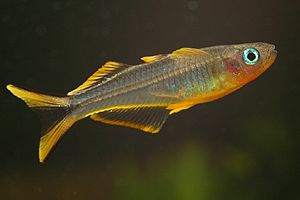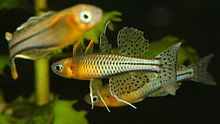Blue eyes
| Blue eyes | ||||||||||||
|---|---|---|---|---|---|---|---|---|---|---|---|---|

Fork-tailed blue-eye ( Pseudomugil furcatus ) |
||||||||||||
| Systematics | ||||||||||||
|
||||||||||||
| Scientific name | ||||||||||||
| Pseudomugilidae | ||||||||||||
| Kner , 1867 |
The blue eyes (Pseudomugilidae) are a family of ear fish-like . These fresh or brackish water fish, which remain about five centimeters small, are only found on the island of New Guinea ( Papua New Guinea , Western New Guinea ), on the Aru Islands and in Australia . Some species are kept as freshwater ornamental fish .
features
Blue eyes have a slender, laterally strongly compressed body with large second dorsal and anal fin, in the male some large and erect dorsal fin. The pectoral fins are sometimes set high, the tips often reach over the body. The body is often transparent or not very colored, the fins are often colored. The relatively large eyes are bright blue in almost all species. Some species reach up to 8 centimeters in length (males). The more inconspicuous females stay smaller.
Way of life
The natural habitats of the blue eyes are clear or tea-colored waters, with a few species also brackish mangrove forests . Blue eyes feed on mosquito larvae and other insects from the surface of the water.
Blue eyes are long-term spawners, the females often lay a few eggs daily over a longer period of time. The eggs, which are up to 2 mm in size, have adhesive threads with which they attach themselves to the substrate or plants. The larvae hatch after about two to three weeks.
Systematics
The Pseudomugilidae were previously placed as a subfamily in the rainbow fish family (Melanotaeniidae). However, they differ from these by a different structure in the area of the skull bones, which Saeed, Ivantsoff & Allen in 1989 prompted to set up their own family of blue eyes (Pseudomugilidae). Since 2004 they belong together with the Bedotiidae , Telmatherinidae and Melanotaeniidae in the suborder rainbow fish relatives (Melanotaenioidei). In addition to the scientifically described species listed, some species are still undescribed.
- Genus Kiunga with two species
- Kiunga blue-eye ( Kiunga ballochi ) Allen , 1983
- Bleher's blue-eye ( Kiunga bleheri ) Allen , 2004
- Genus Pseudomugil with 16 described species
- Connie's blue-eye ( Pseudomugil connieae ) ( Allen , 1981)
- Blue-backed blue-eye ( Pseudomugil cyanodorsalis ) Allen & Sarti , 1983
- Fork-tailed blue-eye ( Pseudomugil furcatus ) Nichols , 1955
- Dotted blue-eye ( Pseudomugil gertrudae ) Weber , 1911
- Inconspicuous blue-eye ( Pseudomugil inconspicuus ) Roberts , 1978
- Ivantsoff's blue-eye ( Pseudomugil ivantsoffi ) Allen & Renyaan , 1999
- Pseudomugil luminatus Allen, Unmack & Hadiaty , 2016
- Cape blue-eye ( Pseudomugil majusculus ) Ivantsoff & Allen , 1984
- Honey blue-eye ( Pseudomugil mellis ) Allen & Ivantsoff , 1982
- New Guinea blue-eye ( Pseudomugil novaeguineae ) Weber , 1908
- Marsh blue-eye ( Pseudomugil paludicola ) Allen & Moore , 1981
- Paska's blue-eye ( Pseudomugil paskai ) Allen & Ivantsoff , 1986
- Transparent blue-eye ( Pseudomugil pellucidus ) Allen, Ivantsoff, Shepherd & Renyaan , 1998
- Vogelkop blue-eye ( Pseudomugil reticulatus ) Allen & Ivantsoff , 1986
- Pacific blue-eye ( Pseudomugil signifer ) Kner , 1865
- Black blue-eye ( Pseudomugil tenellus ) Taylor , 1964
- Genus Scaturiginichthys with a species
- Redfin blue-eye ( Scaturiginichthys vermeilipinnis ) Ivantsoff, Unmack, Saeed & Crowley , 1991
The Pacific blue-eye or butterfly blue-eye ( Pseudomugil signifer ) is divided into at least two different subspecies due to a biogeographical boundary.
swell
Individual evidence
- ^ B. Saeed, W. Ivantsoff, GR Allen: Taxonomic revision of the family Pseudomugilidae (Order Atheriniformes) . In: Australian Journal of Marine and Freshwater Research . 40, 1989, pp. 719-787.
- ^ John S. Sparks and W. Leo Smith, Phylogeny and biogeography of the Malagasy and Australasian rainbowfishes (Teleostei: Melanotaenioidei): Gondwanan vicariance and evolution in freshwater. Molecular Phylogenetics and Evolution 33, 3, pp. 719-734, 2004
- ↑ Heiko Bleher: A Pseudomugil account . In: Fishes of Sahul . tape 22 , no. 4 , 2008, p. 466-470 .
- ↑ BB Wong, JS Keogh, DJ McGlashan: Current and historical patterns of drainage connectivity in eastern Australia inferred from population genetic structuring in a widespread freshwater fish Pseudomugil signifer (Pseudomugilidae) . In: Molecular Ecology . tape 13 , no. 2 , 2004, p. 391-401 , PMID 14717894 .
literature
- Hans Herbert Boeck: Blue eyes. "Butterflies" in the aquarium . Natur und Tier-Verlag, 2012, ISBN 978-3-86659-166-0
- Harro Hieronimus: Rainbow Fish and Kindred Families . ACS, Mörfelden-Walldorf 2002, ISBN 3-931702-80-4 .
- Hans J. Mayland: blue eyes and rainbow fish . Dähne, Ettlingen 2000, ISBN 3-921684-82-X .
Web links
- Blue eyes on Fishbase.org (English)
- Adrian R. Tappin: Pseudomugil Species in Australia and New Guinea (English). Species descriptions, photos, biotopes, keeping and reproduction.
